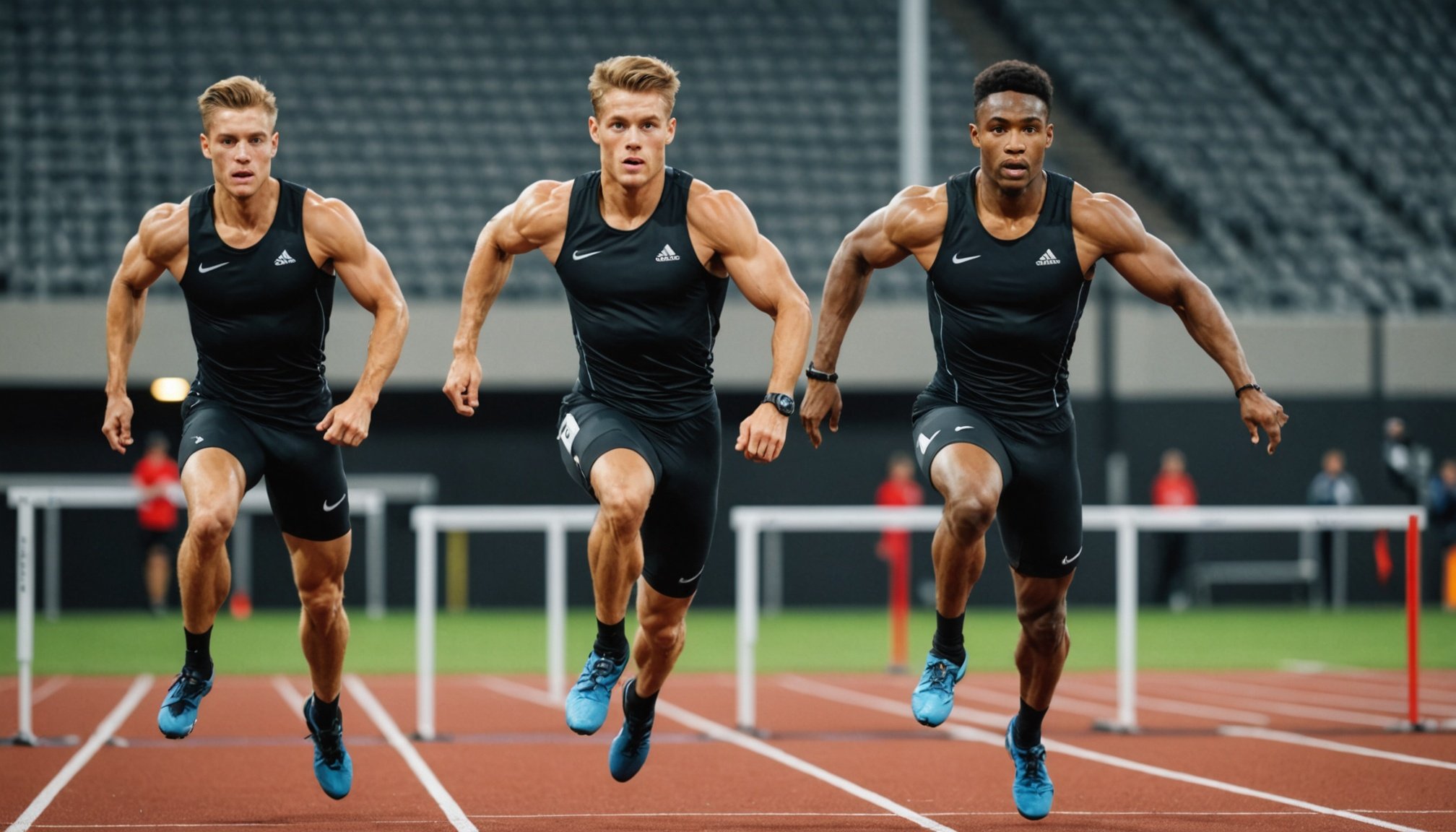Overview of Biomechanical Feedback Technology
Biomechanical feedback represents a significant advancement in understanding athletic performance. In essence, it involves the real-time analysis of an athlete’s physical movements to enhance performance. This technology is pivotal in sports, especially track athletics, where minuscule adjustments can yield substantial improvements.
The core components of biomechanical feedback include sensors and cameras. Real-time data collection methods are paramount as they allow immediate insight into movement dynamics. Sensors, often attached to the athlete’s body, detect kinetic shifts, while high-speed cameras capture motion at thousands of frames per second. This combination ensures precise data collection, facilitating detailed analysis.
Topic to read : Transforming tactical training in field sports: how cutting-edge reality technologies are changing the game
The importance of technology in modern track athletics cannot be overstated. It provides athletes with critical insights into their performance, enabling personalized training adjustments. For instance, athletes can receive feedback on their posture, stride, and speed, allowing them to refine techniques. As a result, biomechanical feedback not only optimizes performance but also minimizes injury risks.
This technological integration offers a competitive edge by enhancing training efficacy and providing a deeper understanding of biomechanics. As athletes strive for excellence, embracing such innovations becomes increasingly indispensable.
In parallel : Mastering snooker: utilizing periodization strategies to enhance performance and prevent burnout
Role of Biomechanical Feedback in Track Athletics
Biomechanical feedback plays a critical role in track and field, offering athletes and coaches detailed insights into movement mechanics. By meticulously analysing an athlete’s movements, feedback systems can pinpoint areas for performance enhancement. These systems are equipped to assess factors such as joint angles, stride lengths, and force distribution. Utilising this data, athletes can adjust their techniques to optimise efficiency and prevent injuries.
Real-time insights are particularly valuable as they allow for immediate correction and adaptation. For instance, when a sprinter is informed about an imbalance in their stride, they can adjust their steps instantly, potentially shaving crucial milliseconds off their time. Such adaptability is invaluable in athletic training, offering a personalised coaching experience that can be tailored to unique physiological capabilities.
Various performance metrics benefit from biomechanical feedback. Key metrics include speed, power, and endurance. By focusing on these areas, athletes gain a comprehensive understanding of their current abilities and what improvements are necessary to achieve their goals. This sustained focus not only improves individual results but also encourages a data-driven approach to athletic development, enhancing the overall standard of performance in track and field.
Methodologies for Enhancing Hurdle Techniques
Developing effective hurdling techniques requires dedication and precision. This section explores the strategies vital for achieving superior performance.
Importance of Correct Technique
Correct hurdling technique is essential as it enhances efficiency and reduces injury risks. Key components include rhythm and balance. Athletes should maintain an upright posture and synchronize their arms and legs. This coordination is crucial for maximizing speed and clearing hurdles smoothly. By focusing on these fundamentals, athletes can achieve improved performance and longevity in their careers.
Specific Drills Utilizing Feedback
Incorporating drills that provide real-time feedback is crucial for technique refinement. Drills like video analysis allow athletes to visualize their form and identify areas for improvement. Coaches can also use auditory cues to guide athletes through each movement, ensuring precision. Utilizing technology enables athletes to make necessary adjustments swiftly and enhances overall performance on the track.
Integration into Training Regimen
Integrating feedback-oriented exercises into the training regimen requires careful planning. Coaches should select drills that align with athletes’ current skill levels, gradually increasing complexity. Consistent feedback enables continuous improvement, allowing for adjustments that contribute to achieving peak performance. By embedding these methodologies, athletes can refine their techniques and strive for excellence in hurdling.
Case Studies and Effectiveness of Biomechanical Feedback
Biomechanical feedback technologies have revolutionised athletic performance by providing precise data and insights. Numerous case studies have highlighted the effectiveness of these innovations in improving training outcomes.
One noteworthy case study demonstrated how a football team utilised feedback systems to enhance player movement and minimise injury risk. This implementation led to a 30% reduction in injuries and a significant increase in performance metrics.
Furthermore, a detailed analysis of training outcomes in swimming revealed marked improvements in stroke efficiency when biometric feedback was employed. Swimmers reported enhanced endurance and quicker recovery times, underscoring the technology’s effectiveness.
Quantitative results often highlight substantial performance improvements. In one track and field study, the incorporation of biomechanical feedback led to a 15% increase in sprint speeds for athletes over a six-month training period. Such tangible outcomes affirm the value of feedback technologies.
Athletes and coaches frequently express positive testimonials regarding their experiences. One coach remarked, “Biomechanical feedback provides us with actionable insights that we couldn’t achieve manually, optimising our training regimes effectively.” These accounts collectively illustrate the profound impact and potential of biomechanical feedback in elevating sports performance.
Visual and Data Analytics in Biomechanical Feedback
In the realm of biomechanical feedback, data visualization is crucial. It transforms complex data sets into comprehensible visual forms, allowing athletes to interpret and leverage insights effectively. When athletes see their performance metrics visually, they can identify patterns, track progress, and make informed decisions about training adjustments.
Visual Representation of Data
Analytics in sports often turns raw data into graphs, charts, and interactive dashboards. These visual elements depict performance metrics such as speed, force, and trajectory, creating a more intuitive understanding of key areas for improvement.
Analytical Tools and Software
Several analytical tools facilitate this process. Software such as Dartfish and Kinovea offer robust capabilities for analyzing biomechanical data, providing real-time feedback essential for precision and improvement. These programs are known for their reliability and usability, making them indispensable in the toolkit of any sports analyst.
User-Friendly Interfaces for Athletes
Creating interfaces that are user-friendly is vital for enhancing athlete engagement. Clear and interactive designs help athletes to better comprehend visual data analytics in sports. When performance metrics are displayed with clarity, they are more likely to motivate athletes and enhance their training results.
Recommendations for Implementation in Training Regimens
Implementing biomechanical feedback into training regimens can significantly boost athlete development. For coaches looking to adopt this implementation strategy, understanding the process is crucial. Start by evaluating the current training program to identify areas that could benefit from training enhancements through biomechanical data. Integrate devices or software that can track critical metrics, selecting tools that align with your athlete’s needs and goals.
Once the technology is in place, coaches should focus on monitoring and adjusting exercises as necessary. Regular assessment of the collected data is essential. This will inform you about necessary modifications, which can lead to improved performance and reduced injury risks. Best practices include scheduling consistent review sessions to discuss progress and adjustments with athletes.
The long-term benefits of incorporating biomechanical feedback stretch beyond immediate improvements. Over time, athletes can refine their movements, optimise energy usage, and achieve higher precision in their sport. This data-driven approach can provide a competitive edge, motivating athletes through tangible evidence of their development. Coaches, embracing this strategy, facilitate a more informed and dynamic training environment, paving the way for enhanced performance outcomes.











